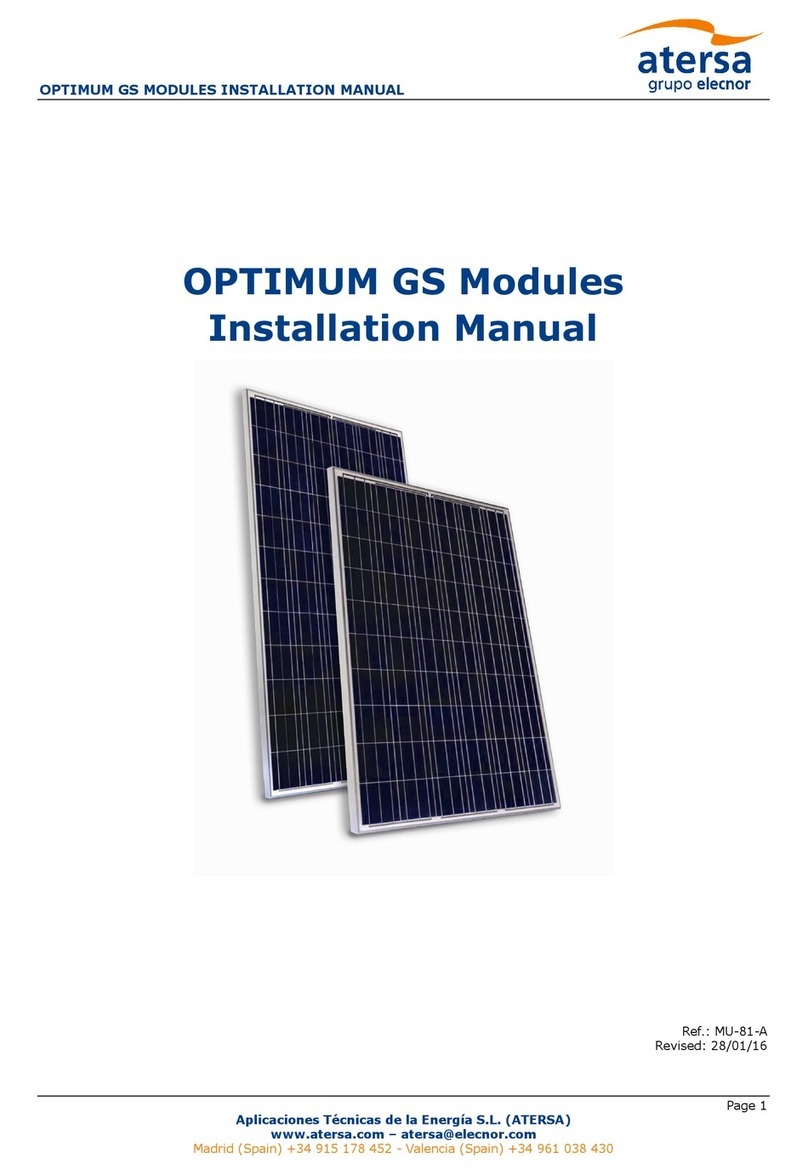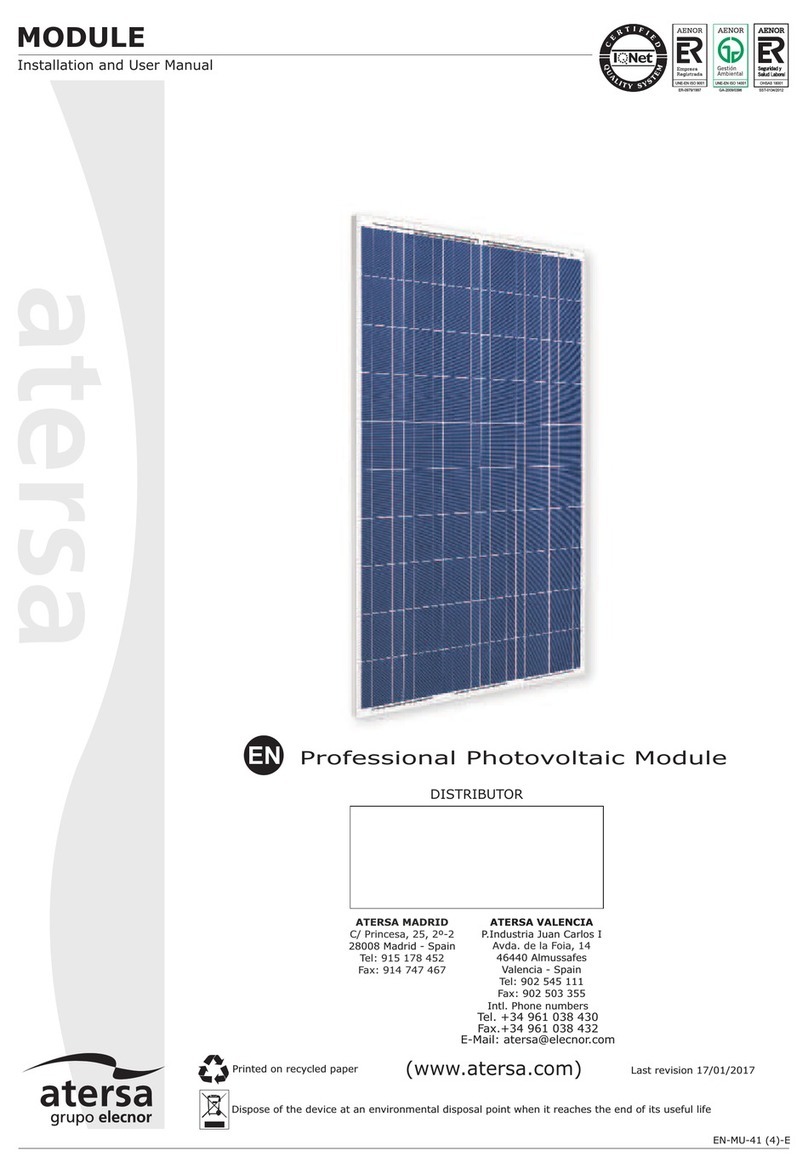
6
MODUL
Installations-und Bedienungsanleitung
DE-MU-41 (2)-A
2
1.- WARNHINWEISE
2.- STANDORTWAHL UND AUFSTELLWINKEL
3.- MONTAGE
Die Nichtbefolgung dieser Anleitung kann zur Zerstörung des Geräts oder zu Personenschäden führen.
Die Module können auf Grundstücken, Terrassen, Dächern und in Innenhöfen aber ebenso an Fassaden, Fenstern, Wänden, Simsen und auf Balkonen
installiert werden. ATERSA denn es hat eine Reihe von Zubehör.
Zur einwandfreien Funktionsweise der Module ist es wichtig, dass keine Hindernisse bestehen, die, zumindest während der Hauptstunden des Tages, die
Verschattungsfreiheit beeinträchtigen (Pflanzenwuchs, Schnee, andere Gebäude, Bauelemente, andere Module etc.).
In der nördlichem Hemisphäre sind die Panels sind Richtung Süden auszurichten. Im Folgenden finden Sie Annäherung für den Erhalt der maximalen
Jahresleistung. Es wird eine Konzeptionsphase von einem Jahr festgelegt, um die Dimensionierung des Generators auf das Verbrauchsbedürfnis und die
Sonneneinstrahlung abzustimmen. Der Neigungswinkel wird mithilfe der folgenden Tabelle bestimmt:
Das Modul darf nicht an einen Ort installiert werden, an dem es im Wasser steht oder kontinuierlich Wasser ausgesetzt ist, beispielsweise durch einen
Sprenger.
Die Montage in salzhaltiger Umgebung muss mit Isolatoren erfolgen, um eine galvanische Korrosion zwischem dem Modul und seiner Unterkonstruktion zu
verhindern.
Die in Reihe geschalteten Solarmodule müssen in derselben Ausrichtung und im selben Winkel angebracht werden. Außerdem sind sie in einem
Mindestabstand von 30cm von der Oberfläche anzubringen, damit die Belüftung gewährleistet ist.
Das Design der ATERSA-Module erlaubt den Wasserabfluss (das Rahmenrohr ist an den Enden offen).
Die Module müssen auf festen und autonomen Konstruktionen angebracht werden, die keine Kräfte auf die Panels übertragen dürfen.
Die langen Seiten des Aluminiumrahmens des Moduls enthalten eine Reihe von Bohrungen von 6,7mm Duchmesser. Zur Montage über der Konstruktion ist
es empfehlenswert, M6-Schrauben aus rostfreiem Stahl zu verwenden. Das Anzugsdrehmoment für das Festziehen der Schrauben liegt zwischen 6 und
8Nm. Folgende Schrauben sind geeignet:
Die Schrauben sind immer mit dem Abstand B angebracht (mit Ausnahme für Module mit dem Format ½ 6” 4x9, bei denen der Abstand C ist), so wie auf
Bild 12 zu sehen. Es müssen mindestens 4 Fixierungen pro Modul angebracht werden.
Die Aluminiumrahmen des Photovoltaik-Moduls von ATERSA verfügen über seitliche Rinnen, die die Anbringung des Moduls auf dem Profil der Anlage
erleichtern. Für die Montage der Module wird ein Hook-System verwendet. Dieses System kann bei Standardkonstruktionen oder bei Führungsprofilen des
Typs “U” eingesetzt werden.
Die Montage auf Standardkonstruktionen wird mittels Klammer, Allen-Schraube M6x16, Federunterlegscheibe, flacher Unterlegscheibe und Mutter M6
durchgeführt.
Für diese Art von Montage ist ein perforiertes Profil des Typs “U” von 41x41 oder 41x21mm notwendig. Diese Elemente werden nicht mit dem Hook-System
mitgeliefert. Das nachfolgende Bild zeigt die vollständig montierte Einheit:
In korrosiver Umgebung (Salznebel) müssen Nylon-Unterlegscheiben verwendet werden.
Setzen Sie die ersten zwei Montagesätze auf und richten Sie sie vertikal auf einer Linie aus. Schrauben Sie die Allen-Schraube bis zum Ansatz ein.
Setzen Sie zwei weitere, vertikal auf einer Linie ausgerichteten Montagesätze auf und schieben Sie sie über die Schiene bis zum Anschlag mit dem
Panel.
Stellen Sie sicher, dass die Module vertikal und horizontal eben zueinander ausgerichtet sind und ziehen Sie die Schrauben bis zum Anschlag an, sodass sie
fest in der Führungsschiene verankert sind.
Die letzten beiden Montagesätze werden auf dieselbe Art und Weise angebracht, wie die ersten, aber in umgekehrter Reihenfolge. Wir fangen nun bei
einem bereits angebrachten Modul an und setzen die Montagesätze auf.
Das Anzugsdrehmoment für das Festziehen der Schrauben liegt zwischen 8 und 10 Nm.
Die Positionierung der Fixierungsklammern, ob des Typs "Hook" oder eines anderen Typs, erfolgt immer im Abstand B, wie im Bild 12 dargestellt (mit
Ausnahme von Modulen des Formats ½ 6” 4x9, bei denen der Abstand C ist). Es sind mindestens 4 Klammern pro Modul anzubringen.
Der Kabeldurchmesser ist wichtig, um zu verhindern, dass es zu Spannungsabfällen kommt, die zu Verlustleistungen in der Anlage führen. Als
Bezugsgröße sind nicht mehr als 1,5% Spannungsabfall zulässig.
Vergewissern Sie sich, dass die Anleitung für die in diesem Dokument aufgeführten Installationen befolgt wird. Reklamationen oder Garantieansprüche können nicht geltend gemacht
werden, wenn nicht wie beschrieben vorgegangen wurde.
Die in dieser Anleitung enthaltenen Sicherheitshinweise müssen für die Sicherheit des Nutzers genau befolgt werden.
Die Kabelführung muss als mechanischer Träger für die Kabelleiter fungieren und über die entsprechende Abdeckung gemäß der Verordnung über elektronische Anlagen mit
Niederspannung verfügen.
Die Bedienung hat durch qualifiziertes Personal zu erfolgen. Die Module erzeugen Strom, wenn sie der Sonne ausgesetzt werden. Die Reihenschaltung von mehreren Modulen kann
gefährliche Spannungen erzeugen. Um das elektrische Risiko während der Montage zu verringern, sollten die Module mit einem lichtundurchlässigen Material bedeckt werden.
Berühren Sie die Enden nicht mit beiden Händen und verwenden Sie immer Isolierwerkzeuge an den elektrischen Verbindungen.
Der Anschluss mit falscher Polarität zerstört die Bypass-Diode des Anschlusskastens.
Das Modul darf nicht konzentriertem Sonnenlicht ausgesetzt werden.
Unter normalen Bedingungen kann das Modul mehr Strom oder Spannung erzeugen, als für durchschnittliche Standardbedingungen angegeben. Dies ist bei der Wahl der Kapazität
des Zubehörs (Kabel, Sicherungen...) zu beachten. Die Voc- und Isc-Werte sind mit dem Faktor 1,25 zu muiltiplizieren.
Die Module dürfen NICHT im mittleren Teil der langen Aluminiumrahmen manipuliert werden.
WICHTIG: NICHTDie Module dürfen mit dem Anschlusskasten unten montiert werden, der Anschlusskasten muss oben liegen.
Montage auf Standardkonstruktionen:
Montage auf Führungsschiene Typ “U”:
*Hinweis:
Montage
KABELDURCHMESSER (Kupferdrahtstärke):
3.1.- Mechanische Installation
3.2.- Elektrische Installation
3.1.1.- Direkt über der Konstruktion
3 .1.2.- Befestigung mittels Hook-System
3.2.1.- Elektroanschluss Anschlusskasten
1B
2
3B
4B
5B
12
12





























